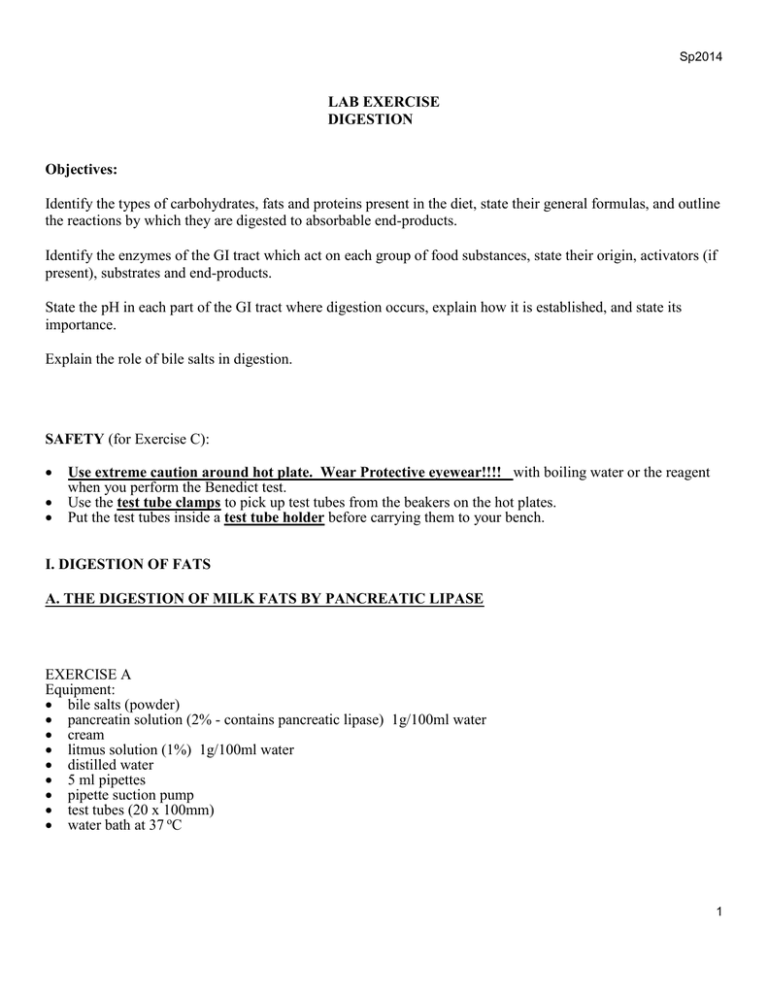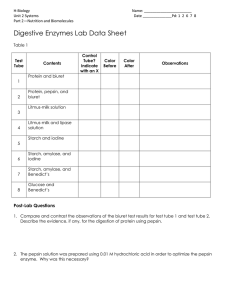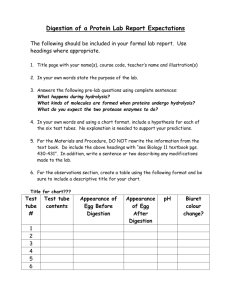i. digestion of fats
advertisement

Sp2014 LAB EXERCISE DIGESTION Objectives: Identify the types of carbohydrates, fats and proteins present in the diet, state their general formulas, and outline the reactions by which they are digested to absorbable end-products. Identify the enzymes of the GI tract which act on each group of food substances, state their origin, activators (if present), substrates and end-products. State the pH in each part of the GI tract where digestion occurs, explain how it is established, and state its importance. Explain the role of bile salts in digestion. SAFETY (for Exercise C): Use extreme caution around hot plate. Wear Protective eyewear!!!! with boiling water or the reagent when you perform the Benedict test. Use the test tube clamps to pick up test tubes from the beakers on the hot plates. Put the test tubes inside a test tube holder before carrying them to your bench. I. DIGESTION OF FATS A. THE DIGESTION OF MILK FATS BY PANCREATIC LIPASE EXERCISE A Equipment: bile salts (powder) pancreatin solution (2% - contains pancreatic lipase) 1g/100ml water cream litmus solution (1%) 1g/100ml water distilled water 5 ml pipettes pipette suction pump test tubes (20 x 100mm) water bath at 37 oC 1 1. Label four test tubes #1A - 2A - 3A - 4A, and add solutions as designated in Table 1. Add the enzyme last! Table 1. Fat Digestion Tests with Pancreatic Lipase and Bile Salts ENZYME (Pancreatic Lipase) Add last Test Tube SUBSTRATE (Cream) BILE SALTS 1A 3.0 ml pinch - 3.0 ml 3.0 ml 2A 3.0 ml pinch 3.0 ml 3.0 ml - 3A 3.0 ml - - 3.0 ml 3.0 ml 4A - pinch 3.0 ml 3.0 ml 3.0 ml DISTILLED WATER INDICATOR (Litmus Solution) 2 Sp2014 Notes: i) Litmus is a pH indicator which changes color from red (below pH 4.5) through various shades of violet to blue (above pH 8.3). Try it yourself: take a test tube, put approximately 1 ml of litmus solution. The color in the test tube is blue. Add a few drops of 2N HCl. Is there a change of color? If yes what is the color? . ii) Enzymatic digestion of fat (triglyceride) releases fatty acids that react with litmus and change its color to red. iii) Pancreatin is a commercial preparation of dried pancreatic enzymes. 2. Shake the tubes to mix thoroughly or use vortex mixer, make note of the color of each tube, and place in a water bath at 37oC. Incubate for 1 to 1 1/2 hours. 3. Shake tubes and record their color in Table 2a every 10 minutes until no color change is observed between color tests. At the end of the incubation period measure the pH of each tube by inserting the probe into the tube. Since the pH probe is too big for the mouth of the test tubes, pour the contents of each test tube into a clean 25 ml beaker. Clean the probe according to standard protocol. Choose terms to describe the colors such as: milky blue, milky violet, milky purple, pinkish purple, reddish purple, transparent blue, transparent red… Write your results in Table 2a. Table 2a. Color observations during digestion tests of milk fat by pancreatic lipase Colors in test tubes during incubation Test tube 0min 10min 20min 30min 40min 50min 60min 70min 80min 90min 1A 2A 3A 4A 3 4. Complete the table below: Table 2b: Summary of results of milk fat digestion tests Test tube Presence of fatty acids (yes/no) Is the digestion of cream, fast, slow or is there no digestion at all? Brief explanation of each result 1A 2A 3A 4A B. DEMONSTRATION OF THE EMULSIFYING PROPERTIES OF BILE SALTS EXERCISE B Equipment: bile salts (powder) distilled water olive oil 1. Prepare two test tubes: In the first one, put 3.0 ml. olive oil and 3.0 ml. distilled water. In the second test tube, put 3.0 ml water and add a pinch of bile salts. Mix with vortex mixer. Then add 3.0 ml of oil. 2. When both test tubes are ready, mix using the vortex mixer. Try to mix one after other within 15 seconds. Put them back in your tray and keep both test tubes until the end of the laboratory period. Do NOT shake them again. Describe the appearance of each test tube after first shaking and changes in the appearance over time. Note generally how long it takes for the oil and water to separate. 4 Sp2014 II. DIGESTION OF CARBOHYDRATES EXERCISE C Equipment: starch solution (1%) distilled water .2N HCl (dropper bottles) pancreatin solution (2% - contains pancreatic amylase) 2g/100ml water test tubes paraffin to cover test tubes pH meter water bath at 37oC iodine solution (Lugol’s) glucose solution (1%) Benedict's solution hot plate test tube clamps THE DIGESTION OF STARCH BY AMYLASE 1. Label four test tubes #1C - 2C - 3C - 4C and add solutions as described in Table 3. Add the enzyme last. Table 3. Carbohydrate Digestion Tests with Pancreatic Amylase Test Tube OTHER REAGENTS SUBSTRATE (starch solution) ENZYME (Pancreatic Amylase) Add last 1C 5.O ml --- 5.0 ml 2C 5.0 ml 5.0 ml dist. Water --- 3C --- 5.0 ml dist. Water 5.0 ml 4C 5.0 ml 10 drops .2N HCl 5.0 ml 2. Shake the tubes and determine and record the pH of each reaction mixture in table 4. Since the pH probe is too big for the mouth of the test tubes, pour the contents of each test tube into a clean 25 ml beaker. The probe fits into these small beakers. After measuring the pH pour the contents of the beaker back into the test tube for incubation. After each pH measurement, clean the probe according to standard protocol. 3. Place the test tubes in a water bath at 37oC and incubate for at least 45 – 60 minutes. Shake the tubes every 15 minutes. (Complete the iodine test and Benedict’s test control test tubes as instructed below while waiting for these tubes to incubate for the 60 minutes) 4. Divide each of the 4 samples by pouring half of it into a clean test tube (label). 5 5. Test one set of 4 test tubes for starch by adding 5 drops of iodine solution. Shake and record the color of the iodine solution in table 4. See the control tests below to analyze results of iodine test. 6. Test the second set of 4 test tubes for reducing sugar by adding 5 ml. of Benedict's reagent to each, and placing in a boiling water bath for 5 min. Remove and rate the precipitate for color according to the following scale: Blue Green + Yellow ++ Orange +++ Red ++++ Record the color of the precipitate in Table 4. See the control tests below to analyze results of Benedict’s test. Iodine solution (Lugol’s) indicates the presence of starch by turning blue or black. Try it yourself! - Prepare three test tubes. Place 2ml of 1% starch solution in one test tube, 2ml of 1% glucose solution in a second, and 2ml of 1% maltose in the third. - Add 5 drops of iodine solution to each test tube and shake. Iodine solution is yellow. Is there any change in color after it is added to the starch solution? If yes, what color is formed? Is there any change in color after it is added to the glucose solution? If yes, what color is formed? Keep these test tubes as controls to compare to the test tubes prepared for starch digestion. Benedict’s reagent tests for the presence of glucose and other reducing sugars. Reducing sugars (glucose, fructose, maltose, lactose, etc.) react with Cu+2 ions (blue, soluble) in Benedict's reagent to form Cu+, which combines with O2 to form Cu2O (red, insoluble). Non-reducing sugars (starch, galactose, sucrose) do not react with Cu+2. Try it yourself! - Prepare three test tubes by adding 5 ml of Benedict's reagent to each test tube - Place 4ml of 1% starch solution in one test tube, 4ml of 1% glucose solution in a second. - Heat in a boiling water bath for 5 min. - Cool. A green, yellow or red precipitate should form if glucose is present. The extent of the color change is related to the amount of red Cu+ formed in relation to the amount of blue Cu++ remaining. This is determined by the amount of glucose present. 6 Sp2014 Record color of the precipitate for starch: Record color of the precipitate for glucose: Keep these test tubes as controls to compare to the test tubes prepared for starch digestion. Table 4. Results of iodine and Benedicts tests for starch digestion by amylase. Test tube pH Iodine test (color) Benedict test (color) Presence of starch (yes/no) Presence of reducing sugar (yes/no) Brief explanation of each result 1C 2C 3C 4C 7 III. DIGESTION OF PROTEINS EXERCISE D Equipment: Egg white, scalpel, balance, weighing boats (1) pepsin in buffer, pH 2.0 (2) pepsin in buffer, pH 8.0 (3) trypsin in buffer, pH 2.0 (4) trypsin in buffer, pH 8.0 and spatula 2% pepsin, 2g/100 ml water 2% pepsin, 2g/100 ml water 2% trypsin, 2 g/100 ml water 2% pepsin, 2g/100 ml water 1. Obtain 4 test tubes and them as shown in table 5. 2. Fill the test tubes with 10 ml of the solutions listed in table 5. 3. Cut and weigh 4 small pieces of egg white and carefully add 1 piece to each tube using a small spatula. Don’t forget to tare the balance with the weighing boat to make weighing easy. 4. Record the weight that was used in each tube in table 5. 5. Incubate at 37oC for 60 – 90 minutes. Try for 90 minutes 6. Pour out most of the liquid from each tube. 7. Remove each the egg white from each tube by tilting the tube and sliding the spatula under the egg white. 8. Remove most of the water by gently placing each side of the egg white on a paper towel, then transfer to a tarred weighing boat and weigh. Record the weights in table 5. 8 Sp2014 Table 5: Digestion of proteins by pepsin and trypsin. Test Tube Solutions 1D pepsin in buffer, pH 2.0 2D pepsin in buffer, pH 8.0 3D trypsin in buffer, pH 2.0 4D trypsin in buffer, pH 8.0 Weight of egg white at start Weight of egg white after incubation Weight change +/- Why was the egg white in buffer solutions without enzymes? Is there any way that the egg white could be transferred to improve the measurement at the end of the incubation period? CLEAN UP: Clean each table top with lysol Return equipment to the location in the prep room. Ask the lab technician or teacher for the return location. 9 LAB REPORT EXERCISE DIGESTION. INTRODUCTION State the purpose of this exercise MATERIALS AND METHODS See the lab manual. RESULTS I: DIGESTION OF FATS 1. Copy results in Table 2a to the table below. Table A. Changes in color observed during the digestion of milk fat by pancreatin. Colors in test tubes during incubation Test tube 0min 10min 20min 30min 40min 50min 60min 70min 80min 90min 1A 2A 3A 4A 2. Briefly describe the distribution of oil with and without bile salts (Exercise B). Describe the appearance of each test tube after first shaking and changes in the appearance over time. Note generally how long it takes for the oil and water to separate. 10 Sp2014 II: DIGESTION OF CARBOHYDRATES In the following table, copy results for the digestion of starch by amylase. Table B. Benedict’s and iodine test results for starch digestion by amylase. Test tube pH iodine test (color) Benedict test (color) Presence of starch (yes/no) Presence of reducing sugar (yes/no) 1C 2C 3C 4C III: DIGESTION OF PROTEINS 1. Complete the following table (Exercise D). Table C. Digestion of egg white protein by pepsin and trypsin. Capillary tubes Solutions 1 pepsin in buffer, pH 2.0 2 pepsin in buffer, pH 8.0 3 trypsin in buffer, pH 2.0 4 trypsin in buffer, pH 8.0 Weight of egg white (+ or -) Amount of egg white that has been digested (in %) 11 2. Prepare one graph showing the percent digestion of egg white by pepsin and trypsin in different buffers. Percent of digestion should be on the Y-axis and pH on the X-axis. Paste or Insert graph below. Describe your results and explain the significance of the tubes filled with egg white incubated in buffers pH 2, and 8. DISCUSSION Answer in the spaces provided below. Do not use extra pages. 12 Sp2014 I: DIGESTION OF FATS Explain what happened in each tube used in Exercise A by completing the following table. Table D: Discussion of results of milk fat digestion by pancreatic lipase Test tube # Is the digestion of cream, fast, slow or is there no digestion at all? Explain. Be sure to include: function of components of the test tube, products of digestion, explanation for color change or no color change, explanation for changes in rate of digestion, etc. 1A 2A 3A 4A What is the significance of using this test tube? 13 II: DIGESTION OF CARBOHYDRATES Explain what happened in each tube used in Exercise C by completing the following table. Table E: Discussion of results of carbohydrate digestion by pancreatic amylase Test tube Presence of starch (yes/no) Presence of reducing sugar (yes/no) Explain your results. 1C 2C 3C 4C III: DIGESTION OF PROTEINS Explain the results you graphed for the digestion of proteins (Exercise D). Explain how optimum pH is created for these enzymes in the gastrointestinal tract (consider the organs secreting these enzymes, the non-enzyme secretions at these locations, and the importance of pH in the activity of each enzyme). 14





